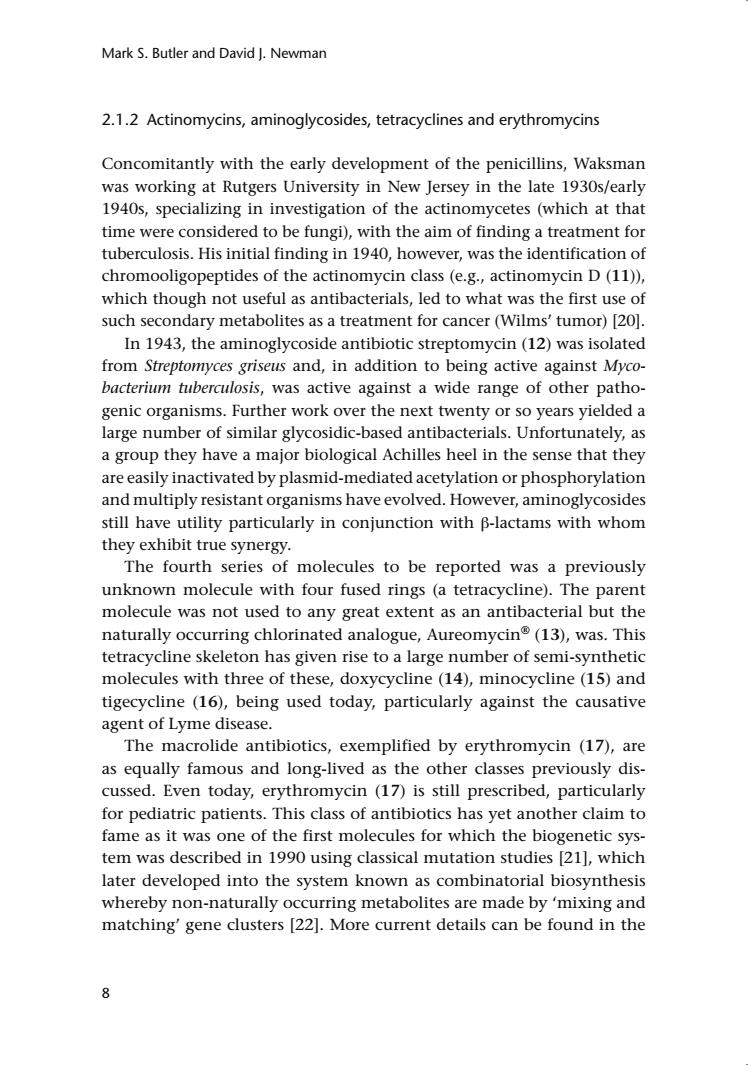正在加载图片...

Mark S.Butler and David J.Newman 2.1.2 Actinomycins,aminoglycosides,tetracyclines and erythromycins Concomitantly with the early development of the penicillins,Waksman was working at Rutgers University in New Jersey in the late 1930s/early 1940s,specializing in investigation of the actinomycetes (which at that time were considered to be fungi),with the aim of finding a treatment for tuberculosis.His initial finding in 1940,however,was the identification of chromooligopeptides of the actinomycin class(e.g.,actinomycin D(11)). which though not useful as antibacterials,led to what was the first use of such secondary metabolites as a treatment for cancer(Wilms'tumor)[20]. In 1943,the aminoglycoside antibiotic streptomycin(12)was isolated from Streptomyces griseus and,in addition to being active against Myco- bacterium tuberculosis,was active against a wide range of other patho- nge mum otmnu a group they have a major biological Achilles heel in the sense that they are easily inactivated by plasmid-mediated acetylation or phosphorylation and multiply resistant organisms have evolved.However,aminoglycosides still have utility particularly in conjunction with B-lactams with whom they exhibit true synergy. The fourth series of molecules to be reported was a previously unknown molecule with four fused rings (a tetracycline).The parent molecule was not used to any great extent as an antibacterial but the naturally occurring chlorinated analogue,Aureomycin(13),was.This tetracycline skeleton has given rise to a large number of semi-synthetic molecules with three of these,doxycycline(14),minocycline(15)and tigecycline (16),being used today,particularly against the causative agent of Lyme disease. The macrolide antibiotics,exemplified by erythromycin (17),are as equally famous and long-lived as the other classes previously dis. cussed.Even today,erythromycin (17)is still prescribed,particularly for pediatric patients.This class of antibiotics has yet another claim to fame as it was one of the first molecules for which the biogenetic sys- tem was described in 1990 using classical mutation studies [21],which later developed into the system known as combinatorial biosynthesis whereby non-naturally occurring metabolites are made by 'mixing and matching'gene clusters [22].More current details can be found in the 8 Mark S. Butler and David J. Newman 8 2.1.2 Actinomycins, aminoglycosides, tetracyclines and erythromycins Concomitantly with the early development of the penicillins, Waksman was working at Rutgers University in New Jersey in the late 1930s/early 1940s, specializing in investigation of the actinomycetes (which at that time were considered to be fungi), with the aim of finding a treatment for tuberculosis. His initial finding in 1940, however, was the identification of chromooligopeptides of the actinomycin class (e.g., actinomycin D (11)), which though not useful as antibacterials, led to what was the first use of such secondary metabolites as a treatment for cancer (Wilms’ tumor) [20]. In 1943, the aminoglycoside antibiotic streptomycin (12) was isolated from Streptomyces griseus and, in addition to being active against Mycobacterium tuberculosis, was active against a wide range of other pathogenic organisms. Further work over the next twenty or so years yielded a large number of similar glycosidic-based antibacterials. Unfortunately, as a group they have a major biological Achilles heel in the sense that they are easily inactivated by plasmid-mediated acetylation or phosphorylation and multiply resistant organisms have evolved. However, aminoglycosides still have utility particularly in conjunction with `-lactams with whom they exhibit true synergy. The fourth series of molecules to be reported was a previously unknown molecule with four fused rings (a tetracycline). The parent molecule was not used to any great extent as an antibacterial but the naturally occurring chlorinated analogue, Aureomycin® (13), was. This tetracycline skeleton has given rise to a large number of semi-synthetic molecules with three of these, doxycycline (14), minocycline (15) and tigecycline (16), being used today, particularly against the causative agent of Lyme disease. The macrolide antibiotics, exemplified by erythromycin (17), are as equally famous and long-lived as the other classes previously discussed. Even today, erythromycin (17) is still prescribed, particularly for pediatric patients. This class of antibiotics has yet another claim to fame as it was one of the first molecules for which the biogenetic system was described in 1990 using classical mutation studies [21], which later developed into the system known as combinatorial biosynthesis whereby non-naturally occurring metabolites are made by ‘mixing and matching’ gene clusters [22]. More current details can be found in the